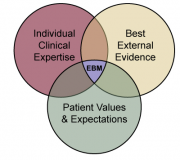Fuente: http://www.physio-pedia.com/Evidence_Based_Practice_(EBP)
Evidence based practice (EBP) is 'the integration of best research evidence with clinical expertise and patient values'[1] which when applied by practitioners will ultimately lead to improved patient outcome.
Evidence Based Practice (EBP)
Original Editor - Rachael Lowe
Lead Editors - Your name will be added here if you are a lead editor on this page. Read more.
Lead Editors - Your name will be added here if you are a lead editor on this page. Read more.
Contents[hide] |
What is EBP?
There are three fundamental components of evidence based practice.
- best evidence which is usually found in clinically relevant research that has been conducted using sound methodology
- clinical expertise refers to the clinician's cumulated education, experience and clinical skills
- patient values which are the unique preferences, concerns and expectations each patient brings to a clinical encounter.
It is the integration of these three components that defines a clinical decision evidence-based. This integration can be effectively acheived by carrying out the five following steps of evidence based practice.
The 5 Steps
One of the fundamental skills required for EBP is the asking of well-built clinical questions. By formulating an answerable question you to focus your efforts specifically on what matters. These questions are usually triggered by patient encounters which generate questions about the diagnosis, therapy, prognosis or aetiology.
The second step is to find the relevant evidence. This step involves identifying search terms which will be found in your carefully constructed question from step one; selecting resources in which to perform your search such as PubMed and Cochrane Library; and formulating an effective search strategy using a combination of MESH terms and limitations of the results.
It is important to be skilled in critical appraisal so that you can further filter out studies that may seem interesting but are weak. Use a simple critical appraisal method that will answer these questions: What question did the study address? Were the methods valid? What are the results? How do the results apply to your practice?
Individual clinical decisions can then be made by combining the best available evidence with the your clinical expertise and your patients values. These clinical decisions should then be implemented into your clinical pra into your practice which can then be justified as evidence based.
The final step in the process is to evaluate the effectiveness and efficacy of your decision in direct relation to your patient. Was the application of the new information effective? Should this new information continue to be applied to practice? How could any of the 5 processes involved in the clinical decision making process be improved the next time a question is asked?
Presentations
| Evaluating Evidence Based Practice: Does EBP Facilitate Wise Clinical Decisions This is a talk by LJ Lee and Roger Kerry, who are both physiotherapists. This talk was presented as a Focused Symposium at the International Federation of Orthopaedic Manipulative Physical Therapists (IFOMPT) 2012 conference in Quebec City, Canada on 4th October 2012. LJ and Roger explore and challenge the notion of evidence based practice (EBP) since its introduction into health care over 20 years ago. The evidence for EBP is investigated, and the role of clinical experience and expertise is analysed. View the presentation |
Resources
Cleland JA, Noteboom JT, Whitman JM, Allison SC (2008) A primer on selected aspects of evidence-based practice relating to questions of treatment, part 1: asking questions, finding evidence, and determining validity, J Orthop Sports Phys Ther. 2008 Aug;38(8):476-84
Noteboom JT, Allison SC, Cleland JA, Whitman JM (2008) A primer on selected aspects of evidence-based practice to questions of treatment, part 2: interpreting results, application to clinical practice, and self-evaluation, J Orthop Sports Phys Ther. 2008 Aug;38(8):485-501
Evidence based practice learning objects that have been developed by the School of Nursing and Midwifery at Nottingham University as part of the RLO-CETL.
Determining the clinical importance of trial results - a learning object developed by the School of Nursing and Academic Division of Midwifery, University of Nottingham
Designing a Questionnaire - a learning object developed by the School of Nursing and Academic Division of Midwifery, University of Nottingham
Advanced Literature Searching - a learning object developed by the School of Nursing and Academic Division of Midwifery, University of Nottingham
Recent Related Research (from Pubmed)
- Evaluation of the effects of an evidence-based practice curriculum on knowledge, attitudes, and self-assessed skills and behaviors in chiropractic students.
- Development and psychometric evaluation of an evidence-based practice questionnaire for a chiropractic curriculum.
- Barriers to implementing evidence-based practice remain high for u.s. Nurses.
- Evidence-based practice for the busy nurse practitioner: Part three: Critical appraisal process.
- Embedding a culture of evidence-based practice.
- Daily Electrode Change and Effect on Cardiac Monitor Alarms: An Evidence-Based Practice Approach.
- Students Connecting Critical Appraisal to Evidence-Based Practice: A Teaching-Learning Activity for Research Literacy.
- Evidence-based practice to improve outcomes of anterior cruciate ligament reconstruction.
- Current evidence on evidence-based practice training in allied health: a systematic review of the literature.
- Motivating medical information system performance by system quality, service quality, and job satisfaction for evidence-based practice.
References
- ↑ Sackett DL, Rosenberg WMC, Gray JAM, Haynes RB, Richardson WS: Evidence based medicine: what it is and what it isn’t. BMJ 1996;312:71-2


No hay comentarios:
Publicar un comentario